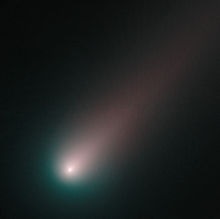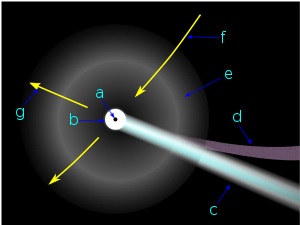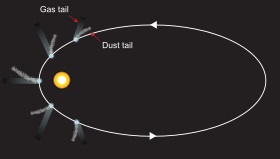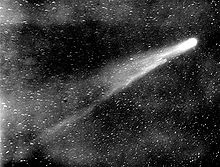|
|
| |
|
|
| |
|
|
|
|
| |
 |
| Hubble image of
Comet ISON shortly before perihelion. |
Comets
A comet is an icy small Solar System body that, when
passing close to the Sun, warms and begins to release
gases, a process called outgassing. This produces a
visible atmosphere or coma, and sometimes also a tail.
These phenomena are due to the effects of solar
radiation and the solar wind acting upon the nucleus of
the comet. Comet nuclei range from a few hundred meters
to tens of kilometers across and are composed of loose
collections of ice, dust, and small rocky particles. The
coma may be up to 15 times the Earth's diameter. If
sufficiently bright, a comet may be seen from the Earth
without the aid of a telescope. Comets have been
observed and recorded since ancient times by many
cultures.
Periodic comets visit again and again. Non-periodic or
single-apparition comets visit only once.
As of 2014 there are 5,253 known comets, a number that
is steadily increasing as they are discovered. However,
this represents only a tiny fraction of the total
potential comet population, as the reservoir of
comet-like bodies in the outer Solar System is estimated
to be one trillion.
Roughly one comet per year is visible to the naked eye,
though many of those are faint and unspectacular.
Particularly bright examples are called "great comets".
Comets have been visited by unmanned probes such as the
European Space Agency's Rosetta, which became the first
ever to land a robotic spacecraft on a comet, and NASA's
Deep Impact, which blasted a crater on Comet Tempel 1 to
study its interior. |
|
 |
| Diagram showing the
physical characteristics of a Comet. a) Nucleus,
b) Coma, c) Gas/Ion tail d) Dust tail, e)
Hydrogen envelope, f) Movement of the Comet g)
Direction to the Sun. |
Physical characteristics
Nucleus
The solid, core structure of a comet is known as the
nucleus. Cometary nuclei are composed of an amalgamation
of rock, dust, water ice, and frozen gases such as
carbon dioxide, carbon monoxide, methane, and ammonia.
As such, they are popularly described as "dirty
snowballs".
However, some comets may have a higher dust content,
leading them to be called "icy dirtballs". Research
conducted in 2014 suggests that comets are like "deep
fried ice cream", in that their surfaces are formed of
dense crystalline ice mixed with organic compounds,
while the interior ice is colder and less dense.
The surface of the nucleus is generally dry, dusty or
rocky, suggesting that the ices are hidden beneath a
surface crust several metres thick. In addition to the
gases already mentioned, the nuclei contain a variety of
organic compounds, which may include methanol, hydrogen
cyanide, formaldehyde, ethanol, and ethane and perhaps
more complex molecules.
In 2009, it was confirmed that the amino acid glycine
had been found in the comet dust recovered by NASA's
Stardust mission. In August 2011, a report, based on
NASA studies of meteorites found on Earth, was published
suggesting DNA and RNA components (adenine, guanine, and
related organic molecules) may have been formed on
asteroids and comets.
The outer surfaces of cometary nuclei have a very low
albedo, making them among the least reflective objects
found in the Solar System. The Giotto space probe found
that the nucleus of Halley's Comet reflects about four
percent of the light that falls on it, by comparison,
asphalt reflects seven percent.
Orbital characteristics
Most comets are small Solar System bodies with elongated
elliptical orbits that take them close to the Sun for a
part of their orbit and then out into the further
reaches of the Solar System for the remainder. Comets
are often classified according to the length of their
orbital periods: The longer the period the more
elongated the ellipse. |
|
 |
| Typical direction of
tails during a comet's orbit near the Sun. |
Effects of comets
Connection to meteor showers
As a result of outgassing, comets leave in their wake a
trail of solid debris too large to be swept away by
radiation pressure and the solar wind. If the Earth's
orbit sends it though that debris, there are likely to
be meteor showers as Earth passes through. The Perseid
meteor shower, for example, occurs every year between 9
and 13 August, when Earth passes through the orbit of
Comet Swift–Tuttle. Halley's Comet is the source of the
Orionid shower in October.
Comets and impact on life
Many comets and asteroids collided with Earth in its
early stages. Many scientists think that comets
bombarding the young Earth about 4 billion years ago
brought the vast quantities of water that now fill the
Earth's oceans, or at least a significant portion of it.
The detection of organic molecules, including polycyclic
aromatic hydrocarbons, in significant quantities in
comets has led to speculation that comets or meteorites
may have brought the precursors of life—or even life
itself—to Earth.
It is suspected that comet impacts have, over long
timescales, also delivered significant quantities of
water to the Earth's Moon, some of which may have
survived as lunar ice.
Observation
A comet may be discovered photographically using a
wide-field telescope or visually with binoculars.
However, even without access to optical equipment, it is
still possible for the amateur astronomer to discover a
sungrazing comet online by downloading images
accumulated by some satellite observatories such as
SOHO. SOHO's 2000th comet was discovered by Polish
amateur astronomer Michał Kusiak on 26 December 2010 and
both discoverers of Hale-Bopp used amateur equipment
(although Hale was not an amateur). |
|
|
Famous comets |
- Halley's Comet
- Hale-Bopp
- Shoemaker-Levy 9
- Ikeya seki
|
 |
| Halley's Comet in
1910. |
History of comets
In old times, people used to be scared of comets. They did
not know what they were, or where they came from. Some
thought that they were fireballs sent from demons or gods to
destroy the earth. They said that each time a comet
appeared, it would bring bad luck with it.
Edmond Halley reasoned that some comets are periodic, that
is, they appear again after a certain number of years, and
again and again. This led to the first prediction of a
comet's return, Halley's Comet, named after him.
Isaac Newton also studied comets. He realised that comets
make U-turns around the sun. He asked his friend Edmond
Halley to publish this in his book Philosophiae Naturalis
Principia Mathematica. Before Newton said this, people
believed that comets go in to the sun, then another comes
out from behind the sun.
All this new information and research gave people
confidence, but some still thought that comets were
messengers from the gods.
In modern times space probes have visited comets to learn
more about them. |
|
|
 Kiddle:
Comets Kiddle:
Comets
Wikipedia: Comets |
|
|
|
|
|
|
|
|
|
|
|
|
|
|
|
|
Search Fun Easy English |
|
|
|
|
|
|
|
|
|
|
|
|
|
|
|
About
Contact
Copyright
Resources
Site Map |